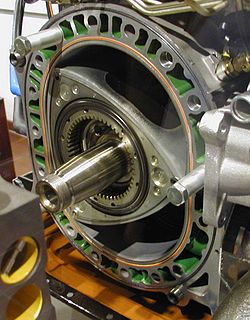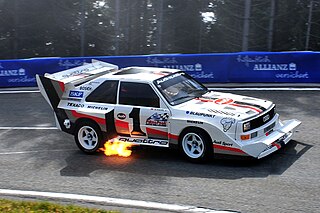
The Wankel engine is a type of internal combustion engine using an eccentric rotary design to convert pressure into rotating motion.

A petrol engine is an internal combustion engine with spark-ignition, designed to run on petrol (gasoline) and similar volatile fuels.

A four-strokeengine is an internal combustion (IC) engine in which the piston completes four separate strokes while turning the crankshaft. A stroke refers to the full travel of the piston along the cylinder, in either direction. The four separate strokes are termed:
- Intake: Also known as induction or suction. This stroke of the piston begins at top dead center (T.D.C.) and ends at bottom dead center (B.D.C.). In this stroke the intake valve must be in the open position while the piston pulls an air-fuel mixture into the cylinder by producing vacuum pressure into the cylinder through its downward motion. The piston is moving down as air is being sucked in by the downward motion against the piston.
- Compression: This stroke begins at B.D.C, or just at the end of the suction stroke, and ends at T.D.C. In this stroke the piston compresses the air-fuel mixture in preparation for ignition during the power stroke (below). Both the intake and exhaust valves are closed during this stage.
- Combustion: Also known as power or ignition. This is the start of the second revolution of the four stroke cycle. At this point the crankshaft has completed a full 360 degree revolution. While the piston is at T.D.C. the compressed air-fuel mixture is ignited by a spark plug or by heat generated by high compression, forcefully returning the piston to B.D.C. This stroke produces mechanical work from the engine to turn the crankshaft.
- Exhaust: Also known as outlet. During the exhaust stroke, the piston, once again, returns from B.D.C. to T.D.C. while the exhaust valve is open. This action expels the spent air-fuel mixture through the exhaust valve.
Knocking in spark-ignition internal combustion engines occurs when combustion of some of the air/fuel mixture in the cylinder does not result from propagation of the flame front ignited by the spark plug, but one or more pockets of air/fuel mixture explode outside the envelope of the normal combustion front. The fuel-air charge is meant to be ignited by the spark plug only, and at a precise point in the piston's stroke. Knock occurs when the peak of the combustion process no longer occurs at the optimum moment for the four-stroke cycle. The shock wave creates the characteristic metallic "pinging" sound, and cylinder pressure increases dramatically. Effects of engine knocking range from inconsequential to completely destructive.

In a motor vehicle, the powertrain or powerplant comprises the main components that generate power and deliver it to the road surface, water, or air. This includes the engine, transmission, drive shafts, differentials, and the final drive. More recently in hybrid powertrains the battery, the electric motor and the control algorithm are also seen as elements of the powertrain.
Lean-burn refers to the burning of fuel with an excess of air in an internal combustion engine. In lean-burn engines the air:fuel ratio may be as lean as 65:1. The air / fuel ratio needed to stoichiometrically combust fuel, by contrast, is 14.64:1. The excess of air in a lean-burn engine emits far less hydrocarbons. High air–fuel ratios can also be used to reduce losses caused by other engine power management systems such as throttling losses.

Gasoline direct injection (GDI), is a form of fuel injection employed in modern two-stroke and four-stroke gasoline engines. The gasoline is highly pressurized, and injected via a common rail fuel line directly into the combustion chamber of each cylinder, as opposed to conventional multipoint fuel injection that injects fuel into the intake tract or cylinder port. Directly injecting fuel into the combustion chamber requires high-pressure injection, whereas low pressure is used injecting into the intake tract or cylinder port.

A back-fire or backfire is combustion or an explosion produced by a running internal combustion engine that occurs in the air intake or exhaust system rather than inside the combustion chamber. Unburnt fuel or hydrocarbons that are ignited in the exhaust system can produce loud sounds even if flames are not present at the tailpipe. A visible flame may momentarily shoot out of the exhaust pipe where the exhaust system is shortened. Fire may also travel into the air intake piping. Either condition may cause a loud popping noise, together with possible loss of power and forward motion. A back-fire is a separate phenomenon from the fire produced by Top Fuel dragsters.

The Honda K-series engine is a line of four-cylinder four-stroke car engine introduced in 2001. The K-series engines are equipped with DOHC valvetrains and use roller rockers to reduce friction. The engines use a coil-on-plug, distributorless ignition system with a coil for each spark plug. This system forgoes the use of a conventional distributor-based ignition timing system in favor of a computer-controlled system that allows the ECU to control ignition timings based on various sensor inputs. The cylinders have cast iron sleeves similar to the B- and F-series engines, as opposed to the FRM cylinders found in the H- and newer F-series engines found only in the Honda S2000.
Homogeneous charge compression ignition (HCCI) is a form of internal combustion in which well-mixed fuel and oxidizer are compressed to the point of auto-ignition. As in other forms of combustion, this exothermic reaction releases energy that can be transformed in an engine into work and heat.
Hydrogen fuel enhancement is the process of using a mixture of hydrogen and conventional hydrocarbon fuel in an internal combustion engine, typically in a car or truck, in an attempt to improve fuel economy, power output, emissions, or a combination thereof. Methods include hydrogen produced through an electrolysis, storing hydrogen on the vehicle as a second fuel, or reforming conventional fuel into hydrogen with a catalyst.
Clean technology refers to any process, product, or service that reduces negative environmental impacts through significant energy efficiency improvements, the sustainable use of resources, or environmental protection activities. Clean technology includes a broad range of technology related to recycling, renewable energy, information technology, green transportation, electric motors, green chemistry, lighting, Greywater, and more. Environmental finance is a method by which new clean technology projects that have proven that they are "additional" or "beyond business as usual" can obtain financing through the generation of carbon credits. A project that is developed with concern for climate change mitigation is also known as a carbon project.
Hybrid vehicle drivetrains transmit power to the driving wheels for hybrid vehicles. A hybrid vehicle has multiple forms of motive power.

HCNG or H2CNG is a mixture of compressed natural gas and 4–9 percent hydrogen by energy. It may be used as a fuel gas for internal combustion engines and home appliances.
Turbo fuel stratified injection (TFSI) is a trademark of the Volkswagen Group for a type of forced-aspiration ("turbo") engine where the fuel is pressure-injected straight into the combustion chamber in such a way as to create a stratified charge. FSI direct injection technology increases the torque and power of spark-ignition engines, makes them as much as 15 percent more economical and reduces exhaust emissions.

The SRM Engine Suite is an engineering software tool used for simulating fuels, combustion and exhaust gas emissions in internal combustion engine applications. It is used worldwide by leading IC engine development organisations and fuel companies. The software is developed, maintained and supported by CMCL Innovations, Cambridge, U.K..

An internal combustion engine (ICE) is a heat engine where the combustion of a fuel occurs with an oxidizer in a combustion chamber that is an integral part of the working fluid flow circuit. In an internal combustion engine, the expansion of the high-temperature and high-pressure gases produced by combustion applies direct force to some component of the engine. The force is applied typically to pistons, turbine blades, rotor or a nozzle. This force moves the component over a distance, transforming chemical energy into useful mechanical energy.
Low-speed pre-ignition (LSPI), also known as stochastic pre-ignition (SPI), is a pre-ignition event that occurs in gasoline vehicle engines when there is a premature ignition of the main fuel charge. LSPI is most common in certain turbocharged direct-injection vehicles operating in low-speed and high-load driving conditions.
Partially premixed combustion (PPC), also known as PPCI or GDCI is a modern combustion process intended to be used in internal combustion engines of automobiles and other motorized vehicles in the future. Its high specific power, high fuel efficiency and low exhaust pollution have made it a promising technology. A PPC engine injects and premixes a charge during compression stroke. Thus premixed charge is too lean to ignite during the compression stroke, the charge will ignite after the last fuel injection ends near TDC. The fuel efficiency and working principle of a PPC engine resemble those of Diesel engine, but the PPC engine can be run with a variety of fuels. Also the partially premixed charge burns clean.
Avinash Kumar Agarwal is an Indian mechanical engineer, tribologist and a professor at the Department of Mechanical Engineering of the Indian Institute of Technology, Kanpur. He is known for his studies on internal combustion engines, Emissions, alternate fuels and CNG engines and is an elected fellow of the American Society of Mechanical Engineering (2013), Society of Automotive Engineers, USA (2012), National Academy of Science, Allahabad (2018), Royal Society of Chemistry, UK (2018), International Society for Energy, Environment and Sustainability (2016), and Indian National Academy of Engineering (2015). The Council of Scientific and Industrial Research, the apex agency of the Government of India for scientific research, awarded him the Shanti Swarup Bhatnagar Prize for Science and Technology, one of the highest Indian science awards for his contributions to Engineering Sciences in 2016.











